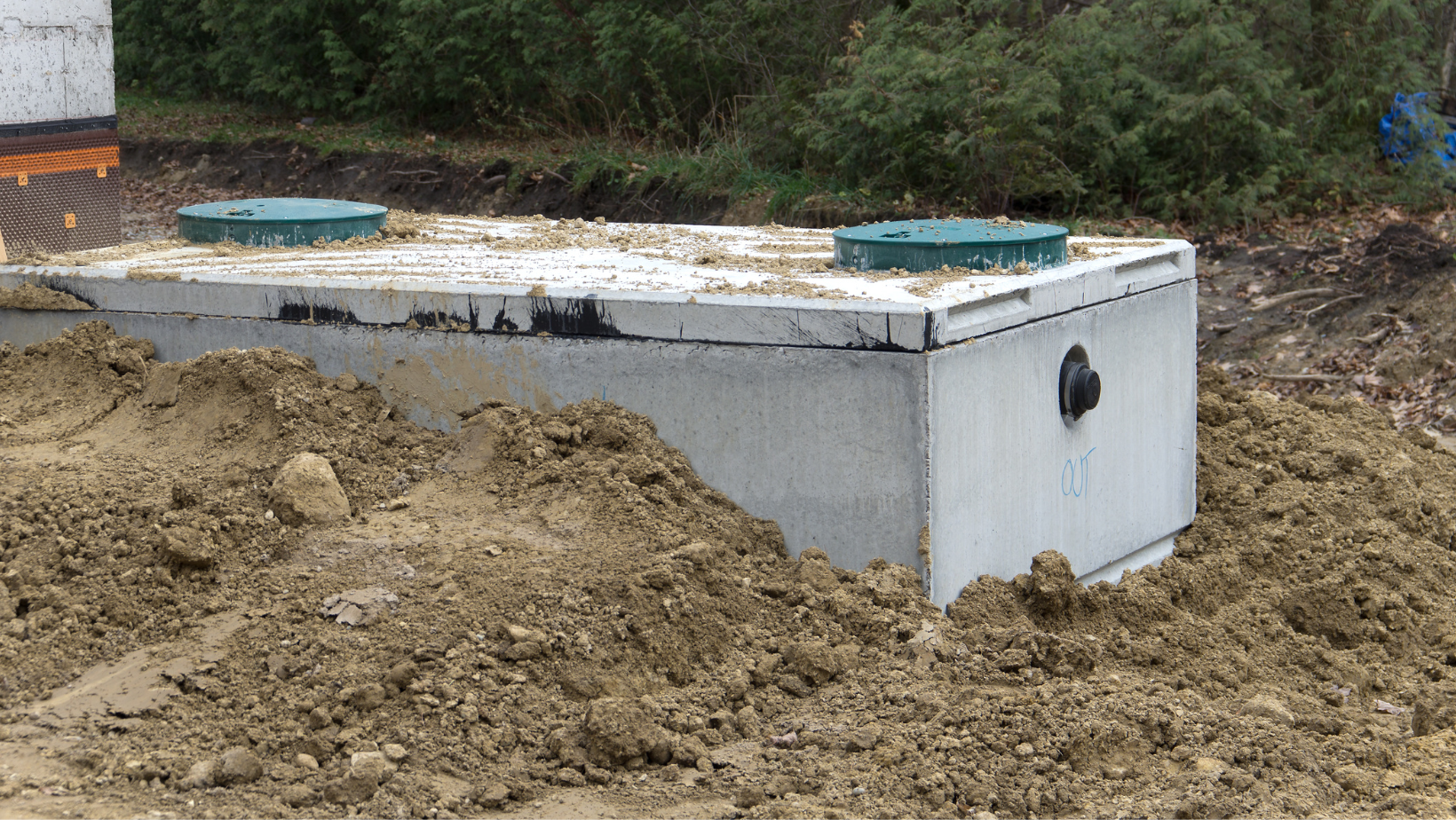Northern Virginia Septic Systems
What homebuyers need to know about septic systems in NVA.
Northern Virginia real estate buyers considering properties in neighborhoods like McLean and Great Falls may encounter septic and well systems for the first time. While the magnitude of information on these systems may be overwhelming, it is important to understand the basic design and functionality of septic and well systems, as well as how to evaluate and maintain them.

The Basics On NVA Septic Systems
Nearly 550,000 households in Virginia depend on onsite systems to take care of sewage disposal. Treated sewage is discharged into the soil or sometimes into various water bodies. Operating a septic system requires several state or federal permits. For Northern Virginia real estate purposes, the term “septic” refers to anaerobic bacteria that develops in the septic holding tank and breaks down the waste discharged into the tank. Septic tanks can be coupled with other on-site wastewater treatment units such as biofilters or aerobic systems involving artificial forced aeration.
Work With Us
We promote transparency, fairness and outstanding value for your DC real estate representation.
Chat on Whatsapp
Bullet Points
- Buyers should request pump records from the current homebowner
- VA Title 5 conforming systems can cost $8k to $20k, depending on environmental factors
- Title 5 upgrades are required prior to a property transfer. Buyers should request upgrade records
Why Septic, Not Sewer?
A septic system’s purpose is to dispose of sewage on a private lot in lieu of pumping it to a waste treatment facility. This system is utilized in many homes located in Great Falls and McLean, Virginia which do not have access to public sewer lines, either because the properties pre-dated the sewer install and never connected when it became available, or because the properties are too far removed from a public sewer line to be reasonably connected.
The Septic System Explained
THE SEPTIC TANK
A septic tank is an underground, watertight recepticle that holds waste products until solids settle, becoming sludge, and scum rises to the surface. Waste water exits the septic tank and flows to the drainfield, then through percolation into the soil where organisms perform the final step in purifying the waste water. Each time new water enters the drainfield, the existing partially-treated water is pushed further down for further treatment until it finally enters the groundwater level.
The septic tank typically contains two chambers separated by a dividing wall with openings located about midway between the floor and roof of the tank. Wastewater enters the first chamber of the tank, allowing solids to settle and scum to float. The settled solids are anaerobically digested, reducing the volume of solids. The liquid component flows through the dividing wall into the second chamber where further settlement takes place, with the excess liquid then draining in a relatively clear condition from the outlet into the drainfield (also known as leach field or seepage field).
Newer tanks have removable lids for easy access in cleaning.
INLET AND OUTLET TEES
Pipes running from the house to the septic tank and from the tank to an additional treatment component (screens etc) or to the drainfield.
DRAINFIELD
Soil beds in which microbes in the soil digest or remove most contaminants from wastewater before it eventually reaches groundwater. Some systems have alternating drainfields controlled by a flow diverter valve. Turning the valve causes the system to use the alternate portion of the drainfield, which extends the overall life of the total field. Suitable soil is necessary for successful wastewater treatment. If your property is severely sloped, if the drainfield is too close to groundwater or surface water, if there are too many conventional systems in one area, or if the soil isn’t suitable for a conventional septic system, an “alternative” system may be used. Some alternative systems rely on sand, peat, plastic media, or wetlands/lagoons instead of soil to promote wastewater treatment.
ADDITIONAL EQUIPMENT
Depending on grade, some septic systems also include a pump to move waste water through the system “Alternative” (non-conventional) systems have different components such as float switches, pumps, aerators, or disinfection devices, among others. The type of device depends on the system.
EPA STATEMENT
“When septic systems are properly designed, constructed, and maintained, they effectively reduce or eliminate most human health or environmental threats posed by pollutants in household wastewater. However, they require regular maintenance or they can fail. Septic systems need to be monitored to ensure that they work properly throughout their service lives.”
Regulation of Northern Virginia Septic Tank Systems
The Virginia Department of Health (VDH) has extensive rules to make certain septic systems do not cause health issues. They have also instigated the mandatory septic tank pump-out every five years in areas that are in danger of contamination from septic discharge. Franklin county and Chesapeake Bay area come under this rule. Northern Virginia real estate owners are required to obtain a certificate verifying their pump-out from authorized personnel certified by the Virginia Department of Health.
NVA REQUIREMENTS
Virginia law requires real estate owners to have their septic tank pumped every 5 years. Without regular pumping, the sludge at the bottom of a septic tank or the grease at the top could be pumped into the drainfield, clogging the network of pipes that make up the drainfield and preventing the wastewater from percolating into the soil.
- Northern Virginia real estate buyers should request pump records from the current homebowner.
- Title 5 conforming systems in Virginia can cost between $8,000.00 and $20,000.00, depending on the environmental factors of the site.
- Title 5 upgrades are required prior to a property transfer. Purchasers of properties with septic systems should request records from the homeowner concerning these upgrades.
Alternative Systems
IN VIRGINIA
Virginia has laws regulating the maintenance and legal operation of alternative septic systems. Any non-conventional system is considered “alternative”. Eco-Flow, Sandfilter, puraflo and Advantex are a few examples. These systems have been available to Northern Virginia real estate owners over the past two decades.
REQUIRED
Assure that the licensed operator visits, collects samples and makes adjustments as needed for proper maintenance of system and to be in compliance with the regulations.
REQUIRED
Make the records available to anyone who purchases the property. In Loudoun County Virginia, an annual 1067 inspection is also required. The inspector must on the Loudoun County approved inspectors list.
COST
The system type will determine the cost of inspections and maintenance, however it should not exceed a few hundred dollars per year, about the same or slightly less than the annual cost of public sewer bills. *When hiring contractors, be aware that Virginia licenses are separate for installers and operators. Contractors may carry both, or just one. Northern Virginia real estate owners should make sure it’s the right one for their needs.
REGULATIONS CAN CHANGE
Over time, regulations can be updated or change. Be sure to consult the septic authority in your location for the most recent updates. This article is provided for informational purposes only.
Questions To Ask About NVA Septic Systems
- Does the seller have the drainfield plat from the county water & sewer authority? (If not, your agent can obtain one for you)
- How many bedrooms does the system rating cover? This information is often not contained in the property listing.
- What type of system is in use? Conventional or alternative system? Does it have a concrete or steel tank? What is the tank size? Is there just a drainfield, or are there separate drywells or seepage pits?
- Where is the equipment located?
- Can the current Northern Virginia homeowner provide records for the service and repair/updating and/or replacement history of the system? Maintenance/pumping records? If a new tank was installed is the seller still using the old drainfield(s)?
- When was the tank last pumped? (Some time should have elapsed between pumping and testing of the system) Has the seller used any additives (such as CCLS)?
- Consider the property’s age and the length of time, if any, the property has been vacant. Accurate testing requires the system to have been consistently utilized up to the time of testing
What Does An NVA Septic System Inspection Include?
- Locating the system
- Uncovering access holes
- Flushing the toilets
- Checking for signs of backup
- Measuring scum and sludge layers
- Identifying any leaks. Inspecting mechanical components
- Pumping the tank if necessary.
Your Northern Virginia service provider should inspect for leaks and look at the scum and sludge layers in your septic tank. If the bottom of the scum layer is within 6 inches of the bottom of the outlet tee or the top of the sludge layer is within 12 inches of the outlet tee, your tank needs to be pumped. Remember to note the sludge and scum levels determined by your service provider in your operation and maintenance records. This information will help you decide how often pumping is necessary.
Four Major Factors That Influence Pumping Frequency
- The number of people in your household
- Amount of wastewater generated (based on the number of people in the household and the amount of water used)
- Volume of solids in the wastewater (for example, using a garbage disposal increases the amount of solids)
- Septic tank size
Water Conservation
- Inspect every 1-3 years
- Pump every 3-5 years, at least
- Reduce water usage to extend the life of your drainfield. The more water a household conserves, the less water enters the septic system. Efficient water use can improve the operation of the septic system and reduce the risk of failure
- Install high-efficiency toilets
- Keep plumbing in good repair. Average indoor water use in the typical single-family home is almost 70 gallons per person per day. Leaky toilets can waste as much as 200 gallons each day!
- Reduce the use of soaps and cleaning products. These kill the “healthy” bacteria that break down the waste in the tank. If you’re a heavy soap and cleaning product user, there are additives you can use to help balance the bacteria. This does NOT mean you do not have to pump as recommended. Check with your local health department before using additives. Commercial septic tank additives can be harmful to the system
- Avoid disposing of harsh chemicals, fats and greases in the sink (for the same reasons as above)
- Limit tree growth near the septic tank and drain field – tree roots can create hard-to-detect damage just as they do with sewer lines
- Don’t run vehicles or heavy equipment over the drainfield. This compresses soil, inhibiting aeration
- Keep roof drains, basement sump pump drains and other rainwater or surface water drainage systems away from the drainfield. Flooding the drainfield with excessive water slows down or stops treatment processes and can cause plumbing fixtures to back up
- Rotate drainfields (if you have more than one) every six months.
Who To Call (Not Us)
Please don’t call us about problems with your septic system, or service requests. We are real estate agents, not septic service providers. This Information Is furnished on our site as a courtesy to our real estate buyers and sellers. Instead, call a professional septic company in your area.
